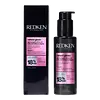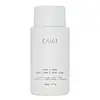What's inside
What's inside
 Key Ingredients
Key Ingredients

No key ingredients
 Benefits
Benefits

 Concerns
Concerns

 Ingredients Side-by-side
Ingredients Side-by-side

Water
Skin ConditioningDimethicone
EmollientPhenyl Trimethicone
Skin ConditioningC11-13 Isoparaffin
SolventIsohexadecane
EmollientDimethiconol
EmollientPropanediol
SolventGlycerin
HumectantAcrylamidopropyltrimonium Chloride
C13-15 Alkane
SolventParfum
MaskingPanthenol
Skin ConditioningOryza Sativa Bran Extract
Skin ConditioningHydrolyzed Hyaluronic Acid
HumectantSodium Hyaluronate
HumectantOryza Sativa Seed Water
AntimicrobialRosmarinus Officinalis Leaf Extract
AntimicrobialHelianthus Annuus Extract
EmollientHydrogenated Castor Oil/Sebacic Acid Copolymer
EmollientSodium Stearoyl Glutamate
CleansingCaprylyl Glycol
EmollientCetearyl Alcohol
EmollientCoceth-7
EmulsifyingTocopherol
AntioxidantGlyceryl Stearate Se
EmulsifyingSaccharomyces Ferment
Skin ConditioningLactobacillus Ferment
Skin ConditioningLactic Acid
BufferingCellulose Gum
Emulsion StabilisingMicrocrystalline Cellulose
AbsorbentGuar Hydroxypropyltrimonium Chloride
Skin ConditioningCitric Acid
BufferingSorbitan Isostearate
EmulsifyingSodium Hydroxide
BufferingPhenoxyethanol
PreservativeChlorphenesin
AntimicrobialLimonene
PerfumingAlpha-Isomethyl Ionone
PerfumingGeraniol
PerfumingHydroxycitronellal
PerfumingWater, Dimethicone, Phenyl Trimethicone, C11-13 Isoparaffin, Isohexadecane, Dimethiconol, Propanediol, Glycerin, Acrylamidopropyltrimonium Chloride, C13-15 Alkane, Parfum, Panthenol, Oryza Sativa Bran Extract, Hydrolyzed Hyaluronic Acid, Sodium Hyaluronate, Oryza Sativa Seed Water, Rosmarinus Officinalis Leaf Extract, Helianthus Annuus Extract, Hydrogenated Castor Oil/Sebacic Acid Copolymer, Sodium Stearoyl Glutamate, Caprylyl Glycol, Cetearyl Alcohol, Coceth-7, Tocopherol, Glyceryl Stearate Se, Saccharomyces Ferment, Lactobacillus Ferment, Lactic Acid, Cellulose Gum, Microcrystalline Cellulose, Guar Hydroxypropyltrimonium Chloride, Citric Acid, Sorbitan Isostearate, Sodium Hydroxide, Phenoxyethanol, Chlorphenesin, Limonene, Alpha-Isomethyl Ionone, Geraniol, Hydroxycitronellal
 Reviews
Reviews

Ingredients Explained
These ingredients are found in both products.
Ingredients higher up in an ingredient list are typically present in a larger amount.
Alpha-Isomethyl Ionone is a fragrance. It can be synthetically created or naturally occurring.
The scent of Alpha-Isomethyl Ionone is described as "flowery" but can also be "woody".
Naturally occurring Alpha-Isomethyl Ionone may be found in Saccharomyces cerevisiae, or the yeast used to make wine and bread.
The term 'fragrance' is not regulated in many countries. In many cases, it is up to the brand to define this term. For instance, many brands choose to label themselves as "fragrance-free" because they are not using synthetic fragrances. However, their products may still contain ingredients such as essential oils that are considered a fragrance.
Learn more about Alpha-Isomethyl IononeC11-13 Isoparaffin isn't fungal acne safe. It can be bad for oily skin.
Dimethicone is a type of synthetic silicone created from natural materials such as quartz.
What it does:
Dimethicone comes in different viscosities:
Depending on the viscosity, dimethicone has different properties.
Ingredients lists don't always show which type is used, so we recommend reaching out to the brand if you have questions about the viscosity.
This ingredient is unlikely to cause irritation because it does not get absorbed into skin. However, people with silicone allergies should be careful about using this ingredient.
Note: Dimethicone may contribute to pilling. This is because it is not oil or water soluble, so pilling may occur when layered with products. When mixed with heavy oils in a formula, the outcome is also quite greasy.
Learn more about DimethiconeDimethiconol is a silicone that resembles the popular dimethicone. Like other silicones, it is an emollient. Emollients create a thin film on skin to prevent moisture from escaping.
This ingredient helps to create a silky texture and improve spreadability. Due to its high molecular weight and thickness, it is often combined with cyclopentasiloxane.
Limonene is a fragrance that adds scent and taste to a formulation.
It's found in the peel oil of citrus fruits and other plants such as lavender and eucalyptus. The scent of limonene is generally described as "sweet citrus".
Limonene acts as an antioxidant, meaning it helps neutralize free radicals.
When exposed to air, oxidized limonene may sensitize the skin. Because of this, limonene is often avoided by people with sensitive skin.
The term 'fragrance' is not regulated in many countries. In many cases, it is up to the brand to define this term. For instance, many brands choose to label themselves as "fragrance-free" because they are not using synthetic fragrances. However, their products may still contain ingredients such as essential oils that are considered a fragrance.
Learn more about LimoneneParfum is a catch-all term for an ingredient or more that is used to give a scent to products.
Also called "fragrance", this ingredient can be a blend of hundreds of chemicals or plant oils. This means every product with "fragrance" or "parfum" in the ingredients list is a different mixture.
For instance, Habanolide is a proprietary trade name for a specific aroma chemical. When used as a fragrance ingredient in cosmetics, most aroma chemicals fall under the broad labeling category of “FRAGRANCE” or “PARFUM” according to EU and US regulations.
The term 'parfum' or 'fragrance' is not regulated in many countries. In many cases, it is up to the brand to define this term.
For instance, many brands choose to label themselves as "fragrance-free" because they are not using synthetic fragrances. However, their products may still contain ingredients such as essential oils that are considered a fragrance by INCI standards.
One example is Calendula flower extract. Calendula is an essential oil that still imparts a scent or 'fragrance'.
Depending on the blend, the ingredients in the mixture can cause allergies and sensitivities on the skin. Some ingredients that are known EU allergens include linalool and citronellol.
Parfum can also be used to mask or cover an unpleasant scent.
The bottom line is: not all fragrances/parfum/ingredients are created equally. If you are worried about fragrances, we recommend taking a closer look at an ingredient. And of course, we always recommend speaking with a professional.
Learn more about Parfum